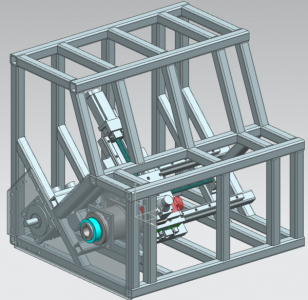- Joined
- May 14, 2015
- Messages
- 179
Anyone having luck using a servo-driven C-axis spindle to turn *and* mill stuff?
I am trying to determine my best options for an upcoming CNC lathe project. As is always the case, the goal is a machine that 'does eveything' but compromises for the resources available. Threading at the very least is a necessity, since this project needs to deliver more functionality than my manual lathe to be worthwhile.
The requirements thus far:
- 110VAC/15A-1ph wall power source
- 1.0-1.5hp spindle power (so I still have enough reserve juice for the axis steppers & controller)
- 4000 spindle speed, belted to motor (fast enough for proper carbide sfm on 1"-2" aluminum parts)
- Articulating spindle (single point threading, live-tool engraving, live-tool light milling/slotting/broaching, possibly rigid tapping if motor is strong enough)
-widget-sized parts in small quantities (so no need for very long duty cycles or aggressive cutting)
Points 3 and 4 seem to suggest a servo, so I am following that rabbit hole at this time.
The questions thus far:
-If using the servo as a controllable C-axis for engraving or light milling (1/8" shank or smaller), will the servo's resistance & mass be sufficient to control tool chatter & cutting forces? These are 4N-m range.
-Is it more efficient to run a high-speed stepped-up-high-voltage servo geared down to the desired RPM, or gearing up a low-speed high-torque servo that operates at near line voltage?
-Most drivers run on Asian/industrial 220-240VAC sources; are there any downsides to using a driver that operates closer to my line voltage?
-Is there any advantage to high vs. low voltage AC brushless servos, or is it really just a function of which controller you want to use?
-Any estimate of losses for transformer or switching voltage booster systems would be helpful to determine my final current draw.
-At what region of the operation envelope do servos+controllers draw the most source current? Is it whenever they are applying max torque, or rather when they are running at high speeds under maximum voltage?
-Could I feasibly use a larger motor and limit its current through the driver software, and would I be giving up torque or speed (or both)?
Anyone having luck using a servo-driven C-axis spindle to turn *and* mill stuff?
I am trying to determine my best options for an upcoming CNC lathe project. As is always the case, the goal is a machine that 'does eveything' but compromises for the resources available. Threading at the very least is a necessity, since this project needs to deliver more functionality than my manual lathe to be worthwhile.
The requirements thus far:
- 110VAC/15A-1ph wall power source
- 1.0-1.5hp spindle power (so I still have enough reserve juice for the axis steppers & controller)
- 4000 spindle speed, belted to motor (fast enough for proper carbide sfm on 1"-2" aluminum parts)
- Articulating spindle (single point threading, live-tool engraving, live-tool light milling/slotting/broaching, possibly rigid tapping if motor is strong enough)
-widget-sized parts in small quantities (so no need for very long duty cycles or aggressive cutting)
Points 3 and 4 seem to suggest a servo, so I am following that rabbit hole at this time.
The questions thus far:
-If using the servo as a controllable C-axis for engraving or light milling (1/8" shank or smaller), will the servo's resistance & mass be sufficient to control tool chatter & cutting forces? These are 4N-m range.
-Is it more efficient to run a high-speed stepped-up-high-voltage servo geared down to the desired RPM, or gearing up a low-speed high-torque servo that operates at near line voltage?
-Most drivers run on Asian/industrial 220-240VAC sources; are there any downsides to using a driver that operates closer to my line voltage?
-Is there any advantage to high vs. low voltage AC brushless servos, or is it really just a function of which controller you want to use?
-Any estimate of losses for transformer or switching voltage booster systems would be helpful to determine my final current draw.
-At what region of the operation envelope do servos+controllers draw the most source current? Is it whenever they are applying max torque, or rather when they are running at high speeds under maximum voltage?
-Could I feasibly use a larger motor and limit its current through the driver software, and would I be giving up torque or speed (or both)?
Anyone having luck using a servo-driven C-axis spindle to turn *and* mill stuff?


